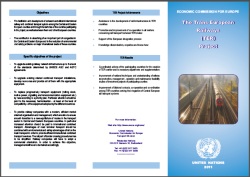About the Trans-European Railway (TER) Project
UNECE TER Project is a sub-regional cooperation among Central, Eastern and South-Eastern European countries.
The main objectives are:
- To improve the quality and efficiency of transport operations,
- To assist the integration process of European transport infrastructure systems, and
- To develop a coherent and efficient international railway and combined transport system in accordance with the UNECE Pan-European infrastructure agreements: European Agreement on Main International Railway Lines (AGC - May 1985) and European Agreement on Important International Combined Transport Lines and Related Installations (AGTC - Feb. 1991).
Basic facts:
- It was established in 1990
- Initial financial support was provided by the United Nations Development Programme (UNDP)
- The executing agency is UNECE
- There are 17 member countries: Armenia, Austria, Bosnia and Herzegovina, Bulgaria, Croatia, Czech Republic, Georgia, Greece, Italy, Lithuania, Poland, Romania, Russian Federation, Serbia, Slovak Republic, Slovenia and Turkey
- In addition, a number of observer countries participate in certain activities of the project: Belarus, Latvia, Moldova, Montenegro, The former Yugoslav Republic of Macedonia and Ukraine
- Azerbaijani membership is pending, awaiting signature for accession
Structure
The TER Project is organized around three pillars:
1. The active participation and support of member countries through the Trust Fund Agreement, deposited with UNECE, which nominates the Project's Steering Committee as its highest administrative and political body, formed by national delegates from each participating country.
2. The Project Central Office in Belgrade, hosted by the Government of Serbia, with Project office personnel coordinating activities.
3. National Project Offices set up or designated in each participating country to liaise between national activities and those under the Project. These national offices operate under the responsibility of a nominated National Coordinator from every member.
The annual and longer term action plans are set by the Steering Committee and the work is done by the Project's personnel, Working Groups, Ad hoc Expert Groups, and when required by external consultants in close co-operation with member countries.
Flyer presenting the Trans-European Railway (TER) Project, available in English:
